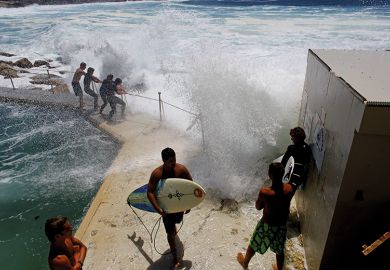The experts appraising Australian higher education have drawn a link between international education and employment issues at universities, in a signal that their review might recommend government action to ease the sector’s financial reliance on overseas students.
In its discussion paper, the Universities Accord panel notes that “the growth of casual academic staff mirrors the growth of international students”. The paper presents graphs illustrating the similarity in both groups’ trend lines.
Department of Education figures show that international higher education student numbers, which in 2013 were hovering below 245,000 in full-time equivalent terms, surged by 62 per cent over the following six years before declining by 8 per cent in 2020.
Casual academic staff at universities followed a similar growth pattern, rising by 33 per cent from 2013 to peak at more than 15,000 in 2019, in full-time equivalent terms. Their numbers then plunged by 12 per cent in the first year of the pandemic.
According to the discussion paper, the trend was particularly pronounced among teaching-only casuals. Their ranks expanded from about 10,000 in 2013 to 14,000 in 2019, receding to 12,000 in 2020.
The paper says financial uncertainty can “influence the employment decisions” of universities and other institutions. It says “many stakeholders” have raised concerns about insecure work and underpayment, particularly among the casual or sessional staff estimated to deliver between 50 and 80 per cent of university undergraduate teaching.
Funding for teaching and learning ranks highly among the issues brought to the panel’s attention, addressed in 57 of the 185 submissions the panel had already received before it issued its discussion paper. International education is not far behind as a topic of concern, raised in 56 submissions.
“The sudden shutdown of international education as a result of the Covid-19 pandemic laid bare the extent to which the sector had become reliant on income from international students,” the National Tertiary Education Union noted in its submission.
“Higher education is one of the most precarious industries in the country. Universities in particular have little focus on workforce planning, instead reacting to ebbs and flows in enrolments and budgetary fluctuations with short-sighted changes to staffing levels.”
University of Melbourne higher education expert Gwilym Croucher said it would be misguided to blame the growth in casualisation exclusively on international education. He said there were other drivers, including industrial relations reforms in the mid-2000s.
Some academics who maintained professional practices were “quite happy” to take on teaching work as casuals, Dr Croucher added. He agreed that casualisation had grown in line with international student numbers, but stressed that this correlation did not entail causation.
Peter Chesworth, acting chief executive of Universities Australia, said Australia’s university workforce had grown in line with the increasing numbers of both domestic and international students over the past decade. He said universities had been forced to make “hard decisions to cut jobs” during the pandemic, with casual positions most affected, but university workforces had “recovered strongly” as the effects of Covid receded.
Education department data suggests that, although overall enrolments rose by 23 per cent between 2013 and 2019, staffing ranks increased by just 15 per cent. Over that period, the casually employed share of the workforce rose from 16 per cent to 18 per cent.
Register to continue
Why register?
- Registration is free and only takes a moment
- Once registered, you can read 3 articles a month
- Sign up for our newsletter
Subscribe
Or subscribe for unlimited access to:
- Unlimited access to news, views, insights & reviews
- Digital editions
- Digital access to THE’s university and college rankings analysis
Already registered or a current subscriber?








